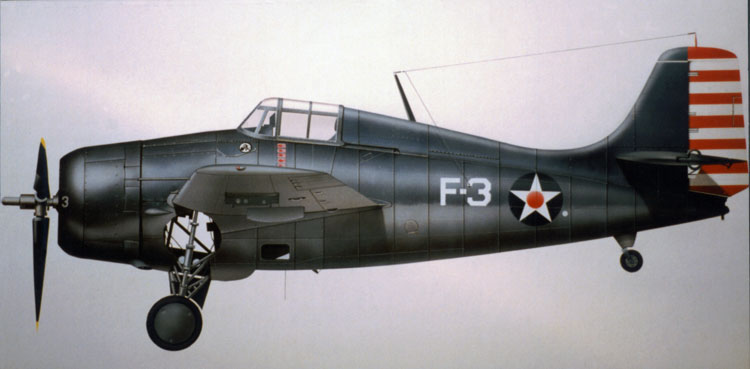Grumman F4F Wildcat

Grumman F4F Wildcat; an airbrush illustration by Les Still
Grumman F4f /FM Wildcat
G-36, Martlet, F4F-1 t0 -4, and Eastern Aircraft FM-1 and -2. Origin;- Grumman Aircraft Engineering Corporation also built by Eastern Aircraft.
Type;- Single seat naval fighter.
Engine;- (XF4F-1) one 1,050hp Pratt and Whitney R-1830-66 Twin Wasp 14 cylinder two row radial, (G-36A, Martlet I, Wildcat I) one 1200hp Wright R-1820-G205A Cyclone nine cylinder radial, (F4F-3) 1,200hp R-1830-76, (F4F-4, and FM-1 Wildcat V) R-1830-86, (FM-2 Wildcat VI) 1,350hp R-1820-56.
Dimensions;- Span 38' (11.6m), length 28'9" (8.5m), Height 11' 11" (3.6m).
Weights;- Empty (F4F-3) 4,425lb, (F4F-4) 4,649lb, (FM-2) 4,900lb, loaded (F4F-3) 5,876lb, (F4F-4) 6,100lb rising to 7,952lb (3607kg) with final FM-1s (FM-2) 7,412lb.
Performance;- Maximum Speed (F4F-3) 325mph (523km/h), (F4F-4, FM-1) 318mph (509km/h), (FM-2) 332mph (534km/h), initial climb typically 2,000' (610m) /min in early versions, 1920' in main production and over 2,000 for FM-2), service ceiling typically 35,000' (10,670m) more in light early versions, range typically 900miles (1448km).
Armament;- (X4F-2) two 0.5in Colt Brownings in fuselage, (F4F-3) four 0.5in in outer wings, (F4F-4 and subsequent) six 0.5in in outer wings, (F4F-4, FM-1 and FM-2) underwing racks for two 250lb (113kg) bombs.
History;- First flight (XF4F-2) 2 September 1937, (XF4F-3) 12 February 1939, production (G-36 and F4F-3) February 1940, (FM-2) March 1943, final delivery August 1945.
Users;- France (FFL), Greece, UK (RN), US (Navy, Marines).
Users;- France (FFL), Greece, UK (RN), US (Navy, Marines).
Development;- Designed as a biplane to continue Grumman's very successful F3F series of single seat carrier fighters, the XF4F-1 was replanned on the drawing board in the summer of 1936 as a mid wing monoplane. Though this machine, the XF4F-2, lost out to the Brewster F2A Buffalo, Grumman continued with the XF4F-3 with a more powerful engine and in early 1939 received a French Aeronavale order for 100, the US Navy following with 54 in August. The French aircraft were diverted to Britain and renamed Martlet I. Production built up with both Twin Wasp and Cyclone engines, folding wings being introduce with the R4R-4, of which Grumman delivered 1,169 plus 220 Martlet IVs for the Fleet Air Arm. Eastern Aircraft Division of General Motors very quickly tooled up and delivered 839 FM-1s and 311 Martlet Vs, the British name then being changed to the US name of Wildcat. Grumman switched to the Avenger, Hellcat and other types but made F4F-7 reconnaissance versions weighing 10,328lb and having 24 hour endurance as well as a floatplane version. eastern took over the final mark, the powerful and effective FM-2, delivering 4,777 of this type ( including 340 Wildcat VI) in 13 months. A Martlet I shot down a Ju88 on Christmas day 1940, and an F4F-3 of VF-211 destroyed a Japanese bomber at Wake Island on 9 December 1941. each event was the first of thousands of furious actions from this quite old fighter emerged with a splendid reputation. Wildcats were especially valuable for their ability to operate from small escort carriers, the pioneer work having been done with British Martlets based in November 1940 on the 5,000 ton captured German vessel Audacity on which a flat deck had been built. Noted for their strength and manoeuvrability, Wildcats even sank Japanese submarines and a cruiser.
from Military Aviation Library - World War 2 United States Aircraft.
Free Tarot Readings by Alison Day
Mystic Realms has linked up with Lotus Tarot, probably the best Tarot Reading site on the internet today.

